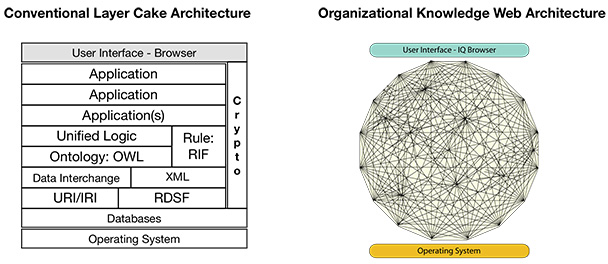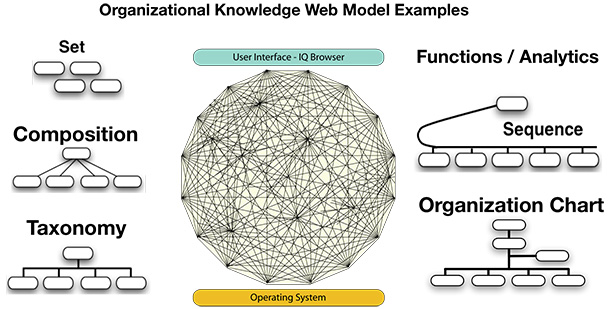An eLearning technology revolution is taking place that only a handful of people know about. Are you one of those people? It is being led by what are known as “organizational knowledge-web” technologies, which are specifically designed to capture, manage, preserve, and deliver organizational knowledge that would otherwise be lost as Boomers retire or other employees leave companies with vital organizational knowledge in their brains.
Just as the Internet is a repository for the world’s data and information, delivered via search engines, websites, and wikis, organizational knowledge-web technologies are designed to capture, manage, and deliver organizational knowledge—only they work better than the Internet. Organizational knowledge webs solve the feelings of frustration that users experience while zigzagging from one hyperlinked web page to the next until they become hopelessly lost in the infoglut. Sometimes researchers refer to this as “the Brownian movement effect.” Organizational knowledge webs use hyperlinks as well, but these systems group knowledge (organizational concepts, ideas, and processes) into common patterns of thought that are further organized around “ontological commitments,” making engagement sessions productive and satisfying.
To demonstrate the ontological commitment principle, if I were to ask you to tell to me all the knowledge that is in your brain, it would be very difficult for you to even begin the process. But if I asked you to tell me about the first time you met a significant person in your life, the concepts, ideas, and images about that person and any circumstances associated with that memory would automatically pop into your mind. Depending on how articulate you are, you could communicate those thoughts to me. This is how ontological commitments work in everyday life. When your mind commits to a central concept, all the relevant concepts and ideas associated with that central concept also surface from memory.
Knowledge-web technologies work the same way. When users access content within uniquely architected organizational knowledge products, all the relevant content related to each concept is also made available to the user. This means that users immediately gain a 360-degree user experience related to the central concept they queried, at the speed of thought. As users click to other associated concepts within a knowledge base, all the relevant knowledge associated with each of those concepts is then made available to them. In this regard, organizational knowledge webs simulate the way people know and reason.
The advantage to organizations of every kind is that when proprietary concepts, ideas, and processes are translated into digitized n-dimensional representations, users can rapidly gain insight and understanding into an organization’s broad organizational structures and functions down to its how, why, and what-if microlearning tasks that are buried deep within every organization—without getting lost in the process. Did you see it coming?
You can see an early example of an Internet knowledge web in a video that was created by Dr. James Burke on a system he developed in the early 2000s at the University of California–Santa Cruz. Dr. Burke demonstrates how people, ideas, and things are interconnected, but his example also demonstrates the Brownian movement effect. Organizational knowledge webs are different because they focus on proprietary organizational knowledge grouped into relevant and comprehensive 360-degree views.
Figure 1 helps demonstrate the difference between conventional database system structures and organizational knowledge web structures.

Figure 1: Comparing conventional database structures and organizational knowledge-web structures
What is significant about organizational knowledge-web technologies is that they provide a means for knowledge engineers and others to develop comprehensive eLearning environments that represent all the concepts, ideas, and thought processes that make an organization work. This means that you can model the inherent depth and complexity of structural, behavioral, functional, and analytical patterns of thought that occur within organizations and integrate them into a single unified knowledge store delivered through the cloud.
Organizational data silos that result from the use of conventional single-purpose applications are about to become a thing of the past. Modern organizational knowledge-web technologies provide a way for non-programming professionals such as subject experts, business analysts, knowledge engineers, and instructional designers to define and seamlessly integrate organizational concepts, ideas, and common patterns of thought that knowledge workers innately understand.
In Figure 2 are a few examples of the thought structures that organizational knowledge-web technologies are designed to model. Keep in mind that these, and a host of other patterns-of-thought models, can be interrelated, commingled, and merged to represent almost any concept or idea. It is this level of functional diversity that makes these systems ideal for organizational knowledge retention and eLearning.
Organizational knowledge webs excel as learning tools because knowledge content is based on the very patterns of thought that people learn through enculturation, education, life experience, and analytic thought. These webs allow learners to traverse across and through modeled content using the same kind of icons and hyperlinks they use to traverse the Internet. Anecdotal evidence suggests, however, that eLearners find the learning experience on organizational knowledge-web systems to be more engaging and satisfying because they can quickly gain usable knowledge without the effort required by conventional systems. As one person said, “I can click away until I am happy. It’s fun.”

Figure 2: Thought structures that organizational knowledge webs can model
The eLearning advantage of organizational knowledge webs is that you can capture all the knowledge of a unit, project, department, division, or company and make it available to individuals who have the proper clearance. If eLearners do not have a medium to quickly learn core knowledge, there is a good chance they will bypass learning opportunities because the effort to find and access related knowledge is not convenient. When spur-of-the-moment learning is not available, those moments quickly become lost learning opportunities that occur across every organization, every day, impacting operational efficiency and performance. When you make learning opportunities available through organizational knowledge webs, both the knowledge workers and their organizations win.
Let’s explore this further. Most large organizations deploy 100 or more applications to run their enterprise. So, once organizational-concept models are instantiated within an organizational knowledge web, you can import relevant data from disparate systems on a periodic, near, or real-time basis. What makes this important is that the average knowledge worker is typically only experienced on, or only has access to, two or three enterprise applications. For this reason, when vital content can be rapidly accessed during “the heat of battle,” it can mean the difference between success and failure. Product and service sales are good examples of this requirement, as is almost any version-oriented work product that requires ongoing updating such as policy and procedure manuals, employee handbooks, contracts, and so forth.
It should be noted that organizational knowledge webs are not designed for transaction processing, like those used for credit card processing. They are designed specifically for advanced knowledge acquisition, management, and delivery.
Because knowledge-web technologies interact with people in ways similar to how people think, they can quickly become true co-creative partners with knowledge workers by delivering vital operational DNA across the enterprise. The “Knowledge Age” is about intelligent technologies that communicate with us, not at us. Organizational knowledge-web technologies have come a long way to actualize this reality. Rather than functioning as conventional mechanisms that make people slaves of the very systems that, paradoxically, have increased the efficiency and performance of almost every aspect of our daily lives, knowledge systems reverse the relationship and put people in control.
Organizational knowledge webs solve this problem by presenting content in dynamic visualization formats that embed subordinate concept models, such as how-to knowledge, within larger concept models such as compositions and taxonomies, among others. As eLearners use these systems, subordinate content seamlessly emerges from within the larger knowledge frameworks. This makes gaining a broad overview perspective easy while also gaining exposure to the deep-down microlearning details within the web’s framework. The result is that eLearners are exposed to both the big picture related to organizations, departments, or projects, and to detailed task training within only a few seconds—on demand.
What counts are results. Because organizational knowledge webs work the way people naturally think, eLearners discover that their ability to use these systems is intuitive. This means that the learning curve required to use these systems is very low, and through their use learners are more likely to achieve higher orders of understanding, efficiency, and performance within far less time than what is expected of conventional eLearning systems.
Now you know. Organizational knowledge-web technologies exist. They are alive and well and emerging into the enterprise because they free developers and users from the restrictions of old-style architected technologies. We are in the midst of a renaissance, and that renaissance is about the humanization of technology.

